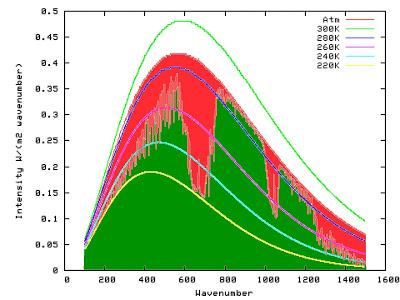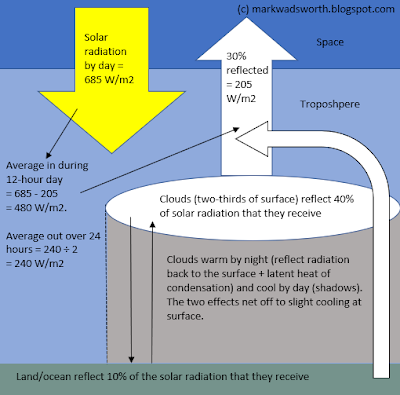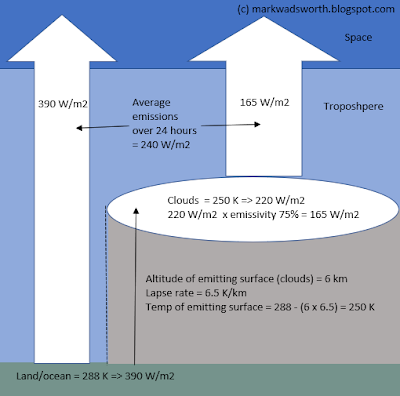From The Motherlode:

The red area shows radiation emitted from Earth's surface, assuming average temperature 288K (total 390 W/m2). The green area shows actual outgoing radiation measured from space (total 240 W/m2). Their argument is that the red area that is not overlapped by green shows the missing radiation that is 'trapped' by CO2. Game, set and match to the Alarmists!
Here's a simplified version to illustrate the point they are trying to make: the surface emits 390 W/m2 but only 240 W/m2 gets to space. How do we explain the missing radiation? The usual suspect, CO2?

Having given this some thought, it strikes me that this way of looking at things is a massive fudge and ignores the full picture.
Let's go back to the beginning and look at incoming solar radiation. On average it's 685 W/m2 during the day. One-third reaches the land or ocean surface, which reflects 10%. Two-thirds hits clouds, which reflect 40%. Overall, 30% is reflected (i.e. Earth's albedo is 0.3), so 480 W/m2 is absorbed during 12 hours of daylight. Temperatures (and outgoing radiation) don't change much by day and night, so let's assume that a steady 240 W/m2 is radiated back to space by day and by night. So it's all in equilibrium. 480 W/m2 x 12 hours incoming = 240 W/m2 x 24 hours outgoing. (Clouds and the surface beneath them have their own separate equilibrium, which need not concern us further).

Outgoing radiation is the reverse process. We treat clouds as part of the surface when calculating albedo, net incoming radiation and effective temperature, so we also have to treat them as part of the surface when looking at outgoing radiation (or else we get nonsensical answers).
One-third of the surface, land/oceans is 288K (effective temperature as adjusted for gravito-thermal effect and latent heat of evaporation/condensation aka "the lapse rate") and they emit 390 W/m2 (they are close to behaving like a 'black body'). Two-thirds of the effective surface, clouds, emit 165 W/m2*, so the weighted average is 240 W/m2. So there is no missing radiation to explain away in the first place!**

* The calculation for clouds is as follows. Average altitude of clouds/emitting layer = 6 km. At 6 km, the temperature is about 250K, i.e. surface temperature 288K minus 6 x 6.5K for the lapse rate. If they behaved like 'black bodies' with emissivity of 100%, they would be emitting (250^4) ÷ 10^8 x 5.67 = 220 W/m2. But clouds' emissivity is only 75% (this is the mid range of a wide range of estimates for different types of cloud, and nobody really knows), so they actually only emit three-quarters of that = 165 W/m2. Emissivity is a bit like 'albedo' but in reverse, look it up.
** OK, I accept that the 'missing' radiation appears to be in the wavelengths absorbed and emitted by CO2, but that's circular logic. They are saying that CO2 absorbs but doesn't emit. They also offer the explanation that CO2 does emit radiation to space, but the more CO2 there is, the higher and cooler the effective emitting layer (not mentioned - it's cooler because of the graivto-thermal effect). Cooler CO2 emits less radiation than warm C02, hence more radiation is 'trapped' hence atmosphere is warmer. But there's more CO2 doing the emitting etc etc.
